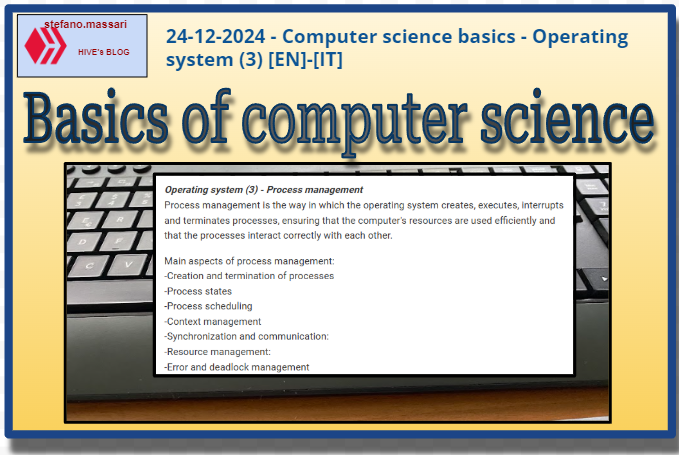
~~~ La versione in italiano inizia subito dopo la versione in inglese ~~~
ENGLISH
24-12-2024 - Computer science basics - Operating system (3) [EN]-[IT]
With this post I would like to give a brief instruction about the topic mentioned in the subject
(code notes: X_81)
Operating system (3) - Process management
Process management is the way in which the operating system creates, executes, interrupts and terminates processes, ensuring that the computer's resources are used efficiently and that the processes interact correctly with each other.
Main aspects of process management:
-Creation and termination of processes
-Process states
-Process scheduling
-Context management
-Synchronization and communication:
-Resource management:
-Error and deadlock management
In summary, process management is a complex set of operations that allows the operating system to make the most of the available resources, maintaining stability and correctness in the execution of programs.
The process management module is responsible for the execution of processes and the allocation of requested resources, coordinating the efficient use of the resources themselves and of the process and allowing the simultaneous execution of multiple processes. In the layered representation of the operating system, the process management module is part of the kernel and is in direct contact with the hardware.
Below is the description of some processes of an operating system
Process Control Block
The Process Control Block (PCB) is a fundamental data structure in operating systems. It contains all the information necessary to manage and monitor a process running on a computer. It is created by the operating system when a process is started and destroyed when the process ends.
Below are some information pills regarding the subject in question.
1-concurrent processes
Processes are concurrent if their execution occurs independently of the termination of the execution of the others.
2-monotasking system
A monotasking system involves an underuse of the computer's resources.
A monotasking system is a system in which the CPU runs only one program (or process) at a time. Although other resources such as memory and I/O devices may be available, the system does not utilize them optimally because the CPU is idle during operations such as reading/writing to disk or waiting for input/output.
This leads to underutilization of resources, as the computer does not fully utilize its ability to perform multiple operations at the same time (as occurs in multitasking systems).
3-process manager
The process manager is located between the hardware and the memory manager
4-multitasking system
In a multitasking system, while a process is waiting for I/O operations, the CPU executes other processes
5-The Process-ID
The Process-ID is a unique numeric identifier associated with a process
6-Process Control Block
The PCB (Process Control Block) includes information about:
⎯ PID and identifier of the user who executed the process
⎯ hardware and software resources currently used by the process
⎯ the state of the processor at the time of its last interruption and content of its registers
⎯ data related to the process
Note: The time of a process is not information contained in the Process Control Block
7-'Ready' state
In the 'Ready' state the process is in central memory and waits for the CPU to be assigned to it
8-interrupt
An interrupt is an interrupt signal that devices and peripherals send to the CPU
9-sequential processes
In sequential processes, processes are executed in sequence
10-the operating system keeps track
For each process, the operating system must keep track of a series of information:
⎯ process status
⎯ at which instruction the process stopped
⎯ on which data the process was operating
⎯ which pages are present in memory
⎯ what privileges are assigned for the execution of the process
⎯ how many times the process used the CPU and for how long each time
⎯ how many I/O operations were performed by the process
NOTE: the number of arithmetic instructions performed by the ALU is not information that the operating system must keep track of
Conclusions
Process management is one of the main functions of an operating system.
Question
I think that the processes with which a computer works could also be replicated in daily work to better perform one's work, what do you think?

[ITALIAN]
24-12-2024 - Basi di informatica - Sistema operativo (3) [EN]-[IT]
Con questo post vorrei dare una breve istruzione a riguardo dell’argomento citato in oggetto
(code notes: X_81)
Sistema operativo (3) - La gestione dei processi
La gestione dei processi è il modo in cui il sistema operativo crea, esegue, interrompe e termina i processi, garantendo che vengano utilizzate efficientemente le risorse del calcolatore e che i processi interagiscano correttamente tra loro.
Aspetti principali della gestione dei processi:
-Creazione e terminazione dei processi
-Stati del processo
-Scheduling dei processi
-Gestione del contesto
-Sincronizzazione e comunicazione:
-Gestione delle risorse:
-Gestione degli errori e dei deadlock
In sintesi, la gestione dei processi è un complesso insieme di operazioni che consente al sistema operativo di sfruttare al meglio le risorse disponibili, mantenendo stabilità e correttezza nell'esecuzione dei programmi.
Il modulo di gestione dei processi si occupa dell’esecuzione dei processi e dell’assegnazione delle risorse richieste, coordinando l’uso efficiente delle risorse stesse e del processo e consentendo l’esecuzione simultanea di più processi. Nella rappresentazione a strati del sistema operativo, il modulo di gestione dei processi fa parte del kernel e si trova a diretto contatto con l’hardware.
Qui di seguito la descrizione di alcuni processi di un sistema operativo
Process Control Block
Il Process Control Block (PCB) è una struttura dati fondamentale nei sistemi operativi. Contiene tutte le informazioni necessarie per gestire e monitorare un processo in esecuzione su un calcolatore. È creato dal sistema operativo quando un processo viene avviato e distrutto quando il processo termina.
Qui di seguito alcune pillole di informazioni a riguardo dell’argomento in oggetto.
1-processi concorrenti
I processi sono concorrenti se la loro esecuzione avviene indipendentemente dalla terminazione dell’esecuzione degli altri.
2-sistema monotasking
Un sistema monotasking comporta un sottoutilizzo delle risorse del calcolatore.
Un sistema monotasking è un sistema in cui la CPU esegue un solo programma (o processo) alla volta. Anche se altre risorse come memoria e dispositivi I/O potrebbero essere disponibili, il sistema non le utilizza in modo ottimale perché la CPU rimane inattiva durante operazioni come lettura/scrittura su disco o attesa di input/output.
Questo porta a un sottoutilizzo delle risorse, poiché il calcolatore non sfrutta pienamente la sua capacità di eseguire più operazioni contemporaneamente (come avviene nei sistemi multitasking).
3-gestore dei processi
Il gestore dei processi si trova tra l'hardware e il gestore della memoria
4-sistema multitasking
In un sistema multitasking, durante i tempi di attesa di un processo per operazioni di I/O, la CPU esegue altri processi
5-Il Process-ID
Il Process-ID è un identificativo numerico univoco associato ad un processo
6-Process Control Block
Il PCB (Process Control Block) comprende le informazioni relative a:
⎯ PID e identificativo dell’utente che ha eseguito il processo
⎯ risorse hardware e software attualmente impiegate dal processo
⎯ lo stato del processore al momento della sua ultima interruzione e contenuto dei suoi registri
⎯ dati relativi al processo
Nota: Non è un'informazione contenuta nel Process Control Block il tempo di un processo
7-Stato 'Pronto'
Nello stato 'Pronto' il processo è in memoria centrale ed attende che gli venga assegnata la CPU
8-interrupt
Un interrupt è un segnale di interruzione che i dispositivi e le periferiche inviano alla CPU
9-processi sequenziali
Nei processi sequenziali, i processi sono eseguiti in sequenza
10-il sistema operativo tiene traccia
Per ogni processo, il sistema operativo deve tenere traccia di una serie di informazioni:
⎯ stato del processo
⎯ a quale istruzione il processo si è interrotto
⎯ su quali dati il processo stava operando
⎯ quali pagine sono presenti in memoria
⎯ quali sono i privilegi assegnati per l’esecuzione del processo
⎯ quante volte il processo ha utilizzato la CPU e per quanto tempo ogni volta
⎯ quante operazioni di I/O sono state svolte dal processo
NOTA: non è un'informazione di cui deve tener traccia il sistema operativo il numero delle istruzioni aritmetiche compiute dall'ALU
Conclusioni
La gestione dei processi è una delle funzioni principali di un sistema operativo.
Domanda
Io penso che i processi con cui lavori un computer potrebbero anche essere replicati nel lavoro quotidiano per effettuare meglio il proprio lavoro, voi che ne pensate?
THE END

